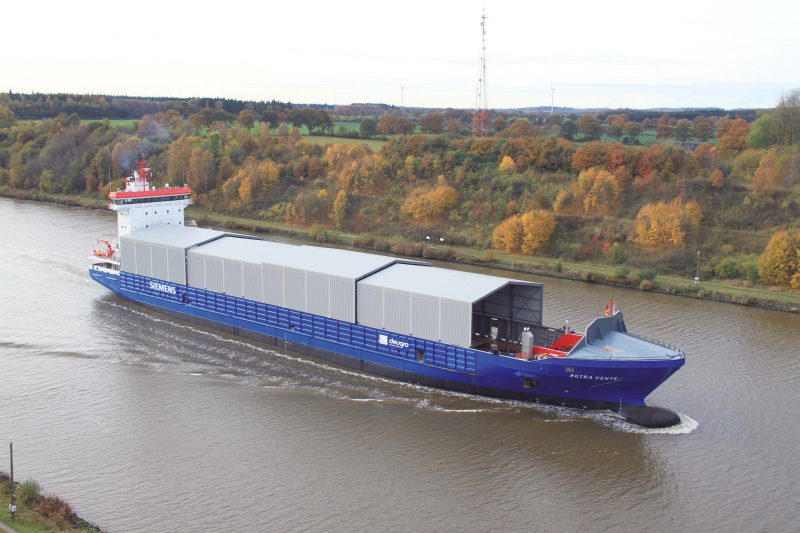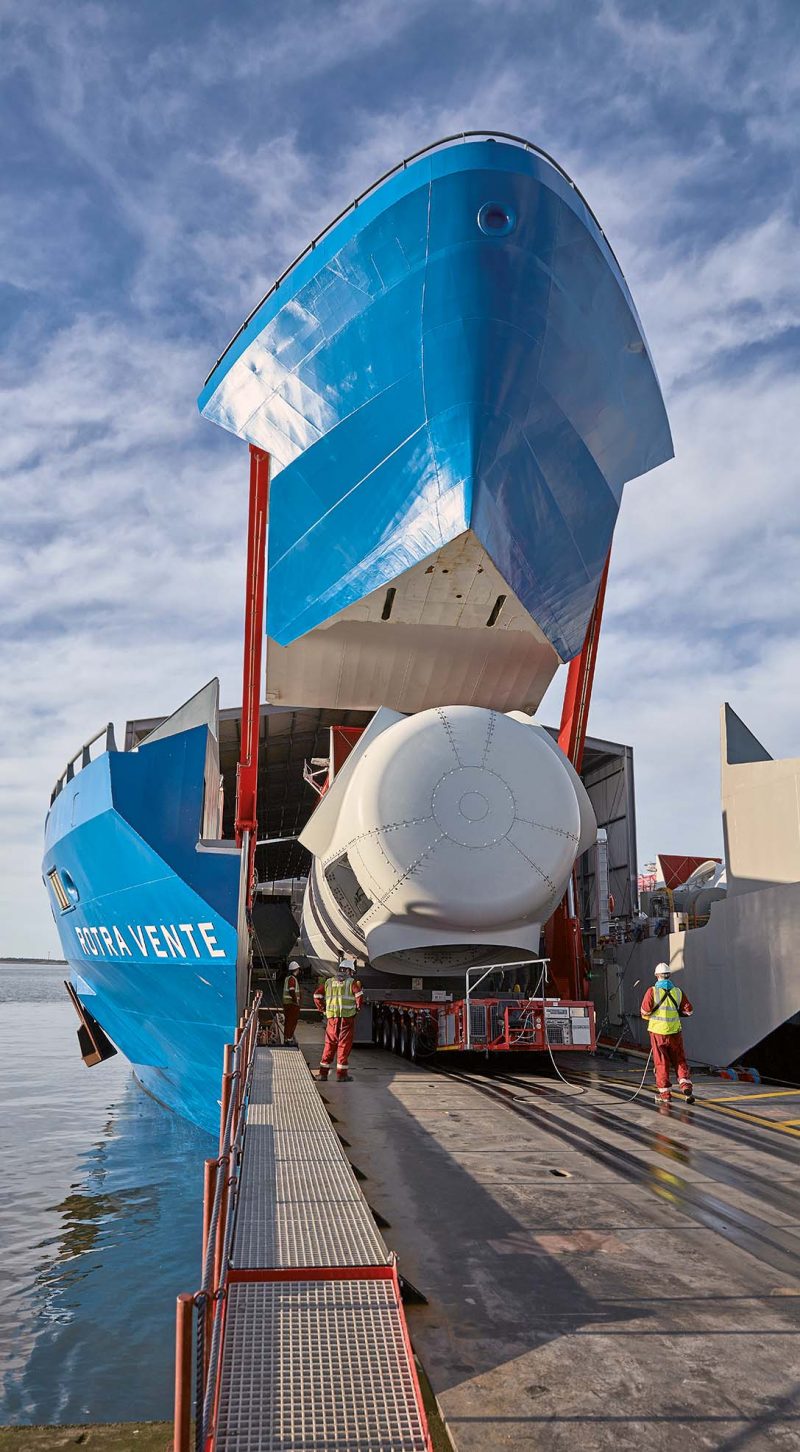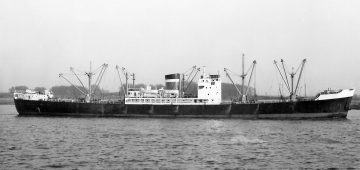The shipping industry has faced many challenges in recent years with Owners and Operators frequently looking to employ their vessels in a manner for which they were not originally intended when the primary source of employment suffers a downturn and/or over capacity. Back in 2008 and 2009 the Flinter Group of The Netherlands, which itself went into liquidation in November 2016 when substantial financial support was withdrawn by finance bank ING, took delivery of two of four 7,702gt, 9,620dwt and 767 TEU capacity feeder container ships from the Nantong Mingde Heavy Industry Stock Co. Ltd. shipyard in the Tongzhou District of Nantong, China. The ships, named Flintercape and Flintercarrier (now operating as the ARA Liverpool and X-Press Mulhacen) were 141.60m long with a 20.60m beam and a draught of 7.72m. The option for the second pair of ships, to be christened Flintercoral and Flinterclear, was abandoned during the build owing to a huge decline in time charter rates in 2008 as Short-Sea Shipping hit turbulent times. The incomplete vessels languished at the Benkien Shipyard in Haiphong until onward sale that saw the Flintercoral towed to The Netherlands by Kotug’s 463gt/2009 built RT Peter loaded with a cargo of new river barges. The ensemble arrived in Rotterdam on 25th April 2010.
Winds of Change
The new vessels aboard the towed ship were in connection with the Concordia Group of Holland, who acquired the incomplete ship. The Concordia Group’s traditional activity encompasses inland waterway vessels, built in China and outfitted in the Netherlands, with a more recent diversification into seagoing vessels. After a long period in lay-up, the shell of the Flintercoral was moved to Concordia’s facility at Werkendam (located near Dordrecht) by Holland Shipyard tugs Eddy Tug and Gepke III from where she had presided at ‘s-Gravendeel on 22nd August 2014. Over the next three months the three cargo hatches and container hold structures, upper sides of the hull, deck furniture and areas of the bow section were removed before the ship (by now described as “semi-submersible”) was moved to the nearby Holland Shipyards outfit in Hardinxveld- Giessendam on 20th November 2014. The remastered Flintercoral, renamed the Rotra Vente, (roughly translating as Wind Rotor – what else?) was about to take centre stage as the first of a new breed of project cargo carrier. On 19th November 2015 the Concordia Group officially announced that it was building the first of two Roll-on/Roll-off special transport vessels, designed especially for the transport of wind turbine nacelles and rotor blades from production facilities owned by Siemens to the wind farm installation ports. A nacelle is the large casing that sits atop the wind turbine pylon and contains the gear box, low and high-speed shafts, generator, controller, and brake. Some nacelles are large enough for a helicopter to land on. Siemens presented this new offshore logistics concept at EWEA 2015 in Paris. The company signed a long-term framework contract with transport service provider Deugro Danmark A/S, utilising the aforementioned purpose-built transport vessels to link Siemens’ existing production locations in Denmark with the new production facilities in Cuxhaven, Germany and Hull, UK. Instead of loading the up-to-75m-long rotor blades and nacelles, each weighing 360t-430t, by crane, the large and heavy components for the D7 offshore wind turbines will be rolled on and off of these new vessels. Siemens developed this customised version of the Ro-Ro concept and Deugro operates the tailor-made transport vessels which have been designed by the Concordia Group. Siemens estimates cost savings of 15-20% compared to standard transport procedures, depending on the location of the offshore wind power plant.
The Concordia Group via its Shipbroker arm was responsible for acquiring the Flintercoral and getting the project underway. The company was founded in 2001 as Concordia Shipyards BV and, since then, has created and delivered more than 125 vessels via shipyards in The Netherlands, China, Belgium, Brazil, Paraguay and Tanzania. The innovative company handles shipbuilding, shipping and offshore projects with the core business being the design and build of sea-going vessels with the key characteristics being economy and innovation. Vessels are also supplied as turn-key projects, completely managed by Concordia. The registered owner of the Rotra Vente is Dutch operator Amasus Shipping BV that trades in the Short Sea segments of sea-river shipping, Short Sea special cargo and Offshore. Amasus has specialised in this trade since 1981 and all new vessels added to the Amasus Shipping and Amasus Offshore fleets since 2008 are smaller than 3,500 tons on average. Most recently the company has taken over several of ABIS Shipping’s 21-strong fleet after this, another Dutch operation, was declared bankrupt in 2016 when financial support was withdrawn. Upon its demise, all ABIS ships were sent to Rotterdam or Malta for lay-up pending auction with Rotterdam also receiving many of the Flinter Group ships that same year.
The Rotra Vente is operated by Siemens Wind Power GmbH & Deugro Danmark A/S, part of the German Deugro Group. The former is a subsidiary of Siemens AG, a global technology powerhouse that has stood for engineering excellence, innovation, quality and reliability for more than 165 years. The company is active in more than 200 countries, focussing on the areas of electrification, automation and digitalisation. One of the world’s largest producers of energy-efficient, resource-saving technologies, Siemens is a leading supplier of efficient power generation and power transmission solutions and a pioneer in infrastructure solutions as well as automation, drive and software resolutions for industry. Siemens generated revenue of €79.6 billion and net income of €5.6 billion in the fiscal year of 2016 and had around 351,000 employees worldwide at that time. Deugro is a German project freight forwarding specialist that has been owned and managed by the same family since 1924. The Danish subsidiary Deugro Danmark A/S is handling the company’s involvement in this scheme. The “keel laying” for the rebuilt ship commenced on 29th December 2015 at the well-established Holland Shipyards facility on the River Merwede at Hardinxveld, The Netherlands. Located less than 40km from Rotterdam, the yard undertakes the construction, repair and conversion of small and medium-sized vessels. The site includes a 100m x 17m slipway, 245m long quayside, a 50m x 18m dock and a ship building shop.
Current Innovation
The 10-month conversion project of a container vessel into a Ro-Ro ship is not an everyday occurrence. The Rotra Vente was originally built under Bureau Veritas class, but due to the extensive modifications which, according to available data, involved the removal of 850t of weight and the addition of 1,250t, the ship was classified as a newbuilding. The new certification was completed by RINA Rotterdam. During the ship’s rebirth the area formerly occupied by the three container hatches gave way to a heavy duty flush Ro-Ro deck with an area of 2,000m2. Because each 8MW wind turbine nacelle weighs up to 430t the deck load capacity per square metre is 17.5t. The three below deck levels, including the former container hold spaces, were converted for the ship’s new role. The Ro-Ro level is Deck 4 and below on Deck 3 are reinforced support structures for the working deck above. Five sea water ballast tanks are located along the outer wall of each side of Deck 3 plus two in the bow. Deck 2 has three such tanks on either side and two in the bow. The sides of the Ro-Ro deck are screened from the elements with a structure also added during the conversion work. The hull itself is double skinned throughout, thus producing a series of void spaces along the perimeter of the three levels beneath the Ro-Ro deck, including the tanktop. The Tanktop features 9 sealed freshwater tanks plus on Deck 2/ Tanktop can be found three marine diesel oil (MDO) and three heavy fuel oil (HFO) tanks with an overall capacity for 1487.2 m³.

The precious high-tech cargoes cannot be transported on an open freight deck as the salt water could harm components. Yes, the equipment is destined for offshore wind farm installations but the nacelles are positioned high above sea level when placed on site. So, the Rotra Vente’s top deck is covered by a roof consisting of four movable sections which, assisted by electric motors, can be rolled forward or aft. The two middle sections are slightly lower in height so can be retracted into the outer sections. With the roof segments retracted, other oversized project cargoes can be loaded aboard if necessary, plus loading/unloading can still be undertaken by crane if circumstances dictate. The freight deck can accommodate a total of eight nacelles for the current Siemens D7 wind turbine platform per voyage. Each of these is rolled aboard on a heavy duty self-propelled modular transporter, taking 45-60 minutes per unit. To aid loading operations the ship is equipped with an automatic heeling tank system and a manual forward/aft trimming system with a capacity of 2,000 cubic metres of ballast water per hour. The electronic automation for the trimming arrangement was supplied by Holland Ship Electric, including a touchscreen operated ballast system.
This company also installed the electrical systems throughout the vessel. The ship to shore Ro-Ro connection is provided by not just a bow visor but a hydraulically powered forecastle, the original bow section converted to a mobile structure. As detailed above, loading in this manner rather than via dock side cranes presents considerable savings and eradicates delays caused by, ironically, high winds. The bow access structure has discarded the industry standard watertight doors in favour of the 85 tonne mobile forecastle being a 500 cubic metre air-tight void space. When lowered, the bow compartment is secured in place with hydraulic locking pins, thus forming the required watertight compartment, while rubber seals prevent water ingress through the gaps. So as not to retain excess weight within the now hydraulically driven forecastle, the anchor gear and windlasses were repositioned slightly aft and outboard from their original location. When at full height above the ship, the raised forecastle provides a Ro-Ro clear height of 11.60m. Connecting the vessel to the quayside is a retractable sliding platform measuring 16.5m in length and 7.45m in width, which is stowed beneath the forecastle. This 70t ramp sits on hydraulically adjustable guide wheels and slides in and out hydraulically along guide rails with support from wire ropes located inboard. The ramp extends up to 6.8m beyond the bulbous bow and a combination of the adjustable guide wheels and ballast tanks can regulate the height of the ramp by a variation of 5.6 metres to suit differing quay heights and tidal movement. The bow mounted Ro-Ro equipment, powered via a dedicated generating system located forward, was designed and engineered by TMS, based in Werkendam, and built by MDConstructions in Rotterdam.
The Rotra Vente offers a draught of 7.10m, a 35m air draught and a gross tonnage of 6,564t. The Net Tonnage is 1,942t, the Deadweight is 8,929dwt and the displacement totals 13,485t. When built as a container vessel, the Rotra Vente was intended to offer a maximum speed of 18.5 knots. Based on the requirements of the ship’s new role plying her trade Denmark- Cuxhaven and Hull-Cuxhaven, it was decided to optimise the propulsion installation for a lower operating speed of 15 knots. The main engine installed is a 5,400kW output Wärtsilä 8L38C that drives a single Wärtsilä Controlled Pitch Propeller. The 600rpm 8L38 engine measures 7,844mm in length, 4,087mm in height and weighs 63t. The cylinder bore is 380mm, the piston stroke is 475mm and the output per cylinder is 725kW. The original propeller was equipped with more twist in the blades than now required with an engine load of just 70% (3,500kW) to deliver the lower service speed. Wärtsilä studied the costs and benefits of remanufacturing the propeller to suit the lower speed and found that engine load decreased by 14%, resulting in a payback period of less than one year. The new propeller blades were subsequently ordered and fitted. Despite the adjustments, the main engine rating was maintained at 5,200kW to comply with the ship’s 1A ice class rating. The ship also has two 511kW Scania DI60 75M auxiliary engines plus one Stamford HCM 534F2, 60Hz, 440V, 608kVA generator. To handle port manoeuvres, a 750kW ZF TT5007CR bow thruster with controllable pitch propeller was installed.
The ship will serve in a SECA area when working across the North Sea so needs to comply with the sulphur emissions regulations, which she does by using MDO. However, a heavy fuel oil (HFO) installation was retrofitted to allow the use of heavy fuel when working elsewhere worldwide, should that opportunity arise. With this capability, the flexibility of the vessel’s revenue earning potential is, in part, future proofed. The accommodation superstructure is traditionally located aft and consists of 6 decks. The Poop Deck features the Officer and Crew Mess Rooms, Galley and an office. Above on A Deck are 5 crew cabins plus the hospital with 5 more cabins on B Deck. On C Deck can be found the Chief Engineer, First Officer and Owner’s cabins/day rooms whilst the Captain’s cabin, day room, office and Pilot’s Cabin are situated on D Deck. Above this level is the Bridge. The ship is manned by a crew of eleven.
New Generation
The Rotra Vente’s place in the spotlight of world shipping took place when her delivery was officially celebrated on 2nd December at the Danish Port of Esbjerg prior to entering service between Cuxhaven (where the nacelles are fabricated), Hull (turbine blade factory) and Esbjerg/Aalborg. The second vessel, the Rotra Mare, is due for delivery in the spring of 2017, a near identical Ro-Ro conversion from a container vessel of a similar design. This ship will accommodate up to 12 rotor blades and transport them from the production facilities in Hull and Aalborg (Denmark), to the respective installation port. The Rotra Mare began life as the 7,720gt Flintercrown. The project to create these two custom-built ships is proof of what can be achieved using a redundant vessel or incomplete newbuild. The Rotra Vente has since been proposed as a candidate for the Nor-Shipping Energy Efficiency Award 2017.

Special thanks must go to Bettina Müller, Head of Global Marketing and Branding, Deugro Group, Hanau, Germany & Bernd Eilitz of Siemens Wind Power GmbH & Co. KG, Hamburg, Germany, for all the invaluable assistance with information, diagrams and images.
Technical Specifications
| Shipyard | Nantong Mingde Heavy Industry Stock Co. Ltd. |
| Place of build | Nantong, China |
| Yard No | 255 |
| Delivery | 2009 (Contract abandoned – incomplete vessel sold 2010 to Concordia Group) |
| Intended Operator | Flinter Group |
| Rebuilt Contract Date | 14/10/2014 |
| Keel Laid | 29/12/2015 |
| Delivery | 30/10/2016 (Official delivery event 2/12/16) |
| Shipyard | Holland Shipyards |
| Place of Rebuild | Hardinxveld-Giessendam, The Netherlands |
| Yard No | HS 146 |
| Owner | SP Vessel 1 BV c/o Amasus Shipping BV, Zijlvest 26, 9936 GZ Farmsum, Netherlands. |
| Operator | Siemens Wind Power GmbH & the Deugro Group |
| Manager | Amasus Shipping BV, Zijlvest 26, 9936 GZ Farmsum, Netherlands |
| IMO | 9805568 |
| Flag | The Netherlands |
| Port of Registry | Werkendam (Originally Rotterdam) |
CLASSIFICATION |
|
| As Built | Unrestricted Navigation – AUT-UMS (SS), ICE CLASS IA, INWATERSURVEY |
| Rebuilt | C – Unrestricted Navigation – AUT-UMS ICE CLASS IA INWATERSURVEY LSF 0.1 MLCDESIGN MON-SHAFT SYS-NEQ-1 |
| Ship Type as Built | Container Vessel of the MINGDE MD098-800TEU-06 design |
| Ship Type as Rebuilt | Heavy Load Carrier – General cargo ship double sideskin |
DIMENSIONS |
|
| Length Overall | 141.60 metres |
| Length (BP) | 132.30 metres |
| Load Line Length | 132.426 metres |
| Beam (Moulded) | 20.60 metres |
| Hull Depth | 9.50 metres |
| Draught | 7.10 metres |
| Air Draught | 35.00 metres |
| Gross Tonnage | 6,564 |
| Net Tonnage | 1,942 |
| Deadweight | 8,929dwt |
| Freeboard | 2,222mm |
| Displacement | 13,485 tonnes |
MACHINERY |
|
| Main Engine | 1x Wärtsilä 8L38C, 5400kW @ 600rpm |
| Propeller | 1x Wärtsilä Controlled Pitch Propeller |
| Auxiliary Engines | 2x Scania DI60 75M, 511kW, 1800rpm |
| Generator | Stamford HCM 534F2, 60Hz, 440V, 608kVA |
| Generator Power | 1,022kW |
| Bow Thruster | 1x ZF TT5007CR, 750kW |
| Service Speed | 15 knots (18.5 knots originally) |
| Fuel | HFO/MDO |
CAPACITIES |
|
| Fuel Bunkers | 1487.2m³ |
| Crew Capacity | 11 Persons |
| Ro-Ro Deck Area | 2000m2 Approx. |
| Deck load | 17.5t/m |
| Ro-Ro Access | 7.45m wide/11.60m clear height via hydraulically operated bow section |
| TEU | 767 (when originally built) |
| Ro-Ro Units | 8 x Nacelle Units |
| No. Complete Decks | 1 |







Comments
Sorry, comments are closed for this item